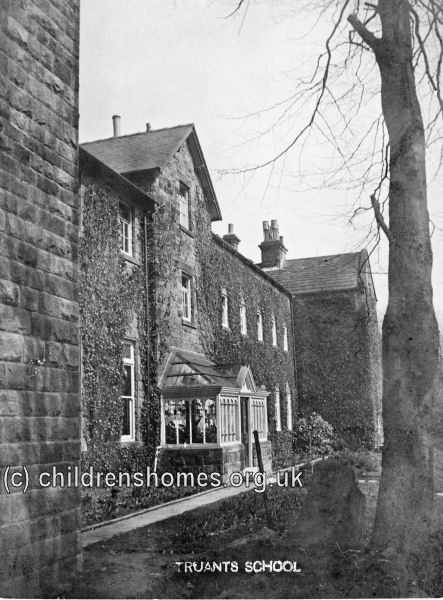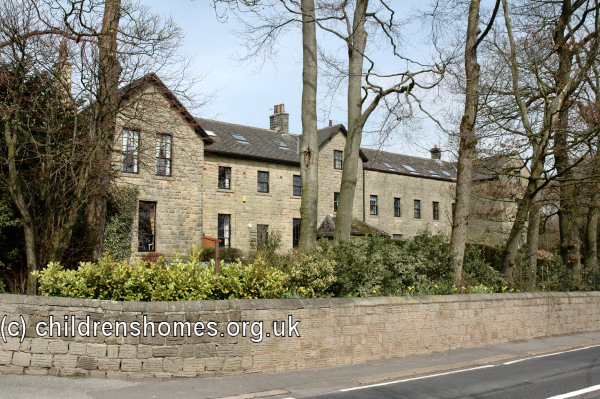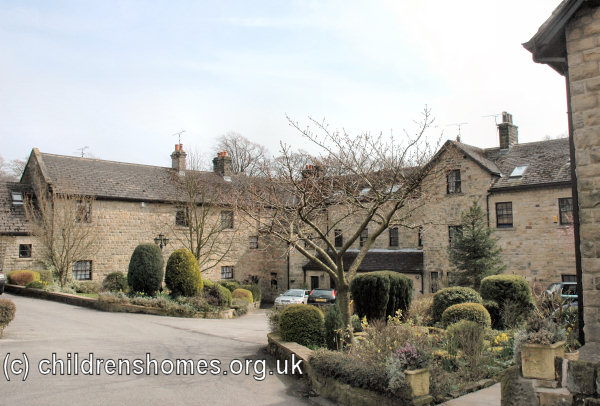Sheffield Truant Industrial School for Boys, Hollow Meadows, near Sheffield, West Riding of Yorkshire
In 1848, the Sheffield Board of Guardians leased from the Duke of Norfolk about fifty acres of moorland, at Hollow Meadows, near Bradfield, about six miles from the Sheffield, with a view to reclaiming it by pauper labour. An ancillary workhouse was then established in an old farmhouse on the site. Nearly the whole of the land was brought under cultivation and sub-let to farm tenants. "The Farm", as it was called, was retained by the Guardians and, in times of downturn in trade in the city, able-bodied men in need of poor relief were sent to labour at the site. Buildings were subsequently erected to house children and the elderly from the Sheffield workhouse.
With the construction of Sheffield's new workhouse at Fir Vale, the Hollow Meadows premises were acquired by the Sheffield School Board for use as a Truant Industrial School. It housed incorrigible truants who were subjected to a strict regime before being released on licence. Subsequent truancy from normal schools would result in re-admission to the Truant School for a longer period, coupled with corporal punishment. After some minor alterations and additions to the buildings were completed, the premises were formally certified for use on March 5th, 1879, and the School opened on May 31st, with accommodation for up to 70 boys. The School's inspector mad it clear, however, that he viewed the existing premises as being of a temporary nature while the truant school system was being trialled. The institution's staff initially comprised the superintendent, Mr Isaac McHardy; matron, Mrs Agnes McHardy; assistant matron, Mrs Sarah Murray; schoolmistress, Miss Sarah Roberts; and a labour master. By the end of 1881, Mr A. Crossland had taken over as schoolmaster.
On his first committal to the School, a boy was kept in solitary confinement for up to four days, the actual duration being at the discretion of the superintendent. During this time, the boy mixed with the others at meals, school, and drill time, and at morning and evening worship. The cells were light, and while in them the boy was given oakum to pick. On a second committal, the maximum time of confinement was a fortnight; on a third or further committal, it was one month. The solitary confinement regime was not one that was widely used and the School's inspector expressed some caution about its adoption.
Three hours each day were spent in secular education, and half an hour was given over religious study. The School's garden provided industrial employment. A little wood-chopping was carried on, and the boys also learned knitting. Two hours were allowed each day for recreation. In December 1880, it was reported that the School was going to add an adjoining farm of 144 acres, with a cottage and farm buildings, and would then be able to accommodate about 20 more boys.
Although plans were being made for major improvements to the accommodation, the condition of the premises received increasing criticism in the School's inspection reports. The dormitories were overcrowded, and had no way of escape in case of fire. There was also no sick-room accommodation. In October, 1883, five cases of 'itch' were noted as being badly lodged in a sort of loft. Discipline was also reported to need improvement, with a lengthy list of corporal punishments having been administered, and 16 boys having been transferred to Industrial Schools. Paper-bag making had been introduced as a wet weather occupation. There were now 100 acres under grass and plough. About 20 cows were kept and 30 young stock. Milk was sent daily to Sheffield.
In 1886, the School's managers finally put their rebuilding plans into action. At the same time, the use of solitary confinement at the beginning of each boy's stay was dropped and no cells for this purpose were included in the new building. The farm was also given up, leaving the School occupying 8½ acres of freehold land and a further 4 acres rented. By August, 1886, Mr T. Wilshaw had succeeded Mr Crossland as schoolmaster.
In the School's 1887 inspection report, the new buildings were described as "suitable, well ventilated and comfortable" and included a good sickroom, nurse's room, and isolating room for suspicious or infectious 'cases. There was also a good playground, and a large play-shed. The School site is shown on the 1901 map below.

Sheffield Truant Industrial School for Boys site, Sheffield, c.1901.

Sheffield Truant Industrial School for Boys from the south-west, Sheffield, c.1910. © Peter Higginbotham

Former Sheffield Truant Industrial School for Boys from the south-east, Sheffield, 2006. © Peter Higginbotham

Former Sheffield Truant Industrial School for Boys from the south-west, Sheffield, 2006. © Peter Higginbotham

Former Sheffield Truant Industrial School for Boys from the north-west, Sheffield, 2006. © Peter Higginbotham
The 1887 report also noted that an unnamed official, since discharged, had been more to blame than the boys for any trouble there had been. Mr Thomas Allsopp was appointed as schoolmaster in succession to Mr Wilshaw. The boys now had about an hour and a half to play in each day, a half-holiday on Saturday for cricket or football, and three-quarters of an hour-drill daily. The only industrial occupations were gardening and house work, and the boys baked their own bread.
In February, 1890, there was an outbreak of influenza at the School, which had affected the superintendent, the labour master, and 17 boys. In April, the assistant matron, Mrs Murray, died of acute inflammation of the lungs after influenza. Of 999 boys licensed since the School's opening up until to December 31st, 1890, 539 had not been re-admitted, 330 once, and 130 twice or more. Mr Allsopp was succeeded as schoolmaster by Mr Ross, who in turn was replaced by Mr H. Stenton in 1892, with Mr Horace Kemp taking over the post in 1894.
The matron, Mrs McHardy, died from heart disease in September, 1893. Mr McHardy then continued as superintendent, with Miss Nimmo appointed as matron. The following year, one of the dormitories, an attic, was fitted with hot water pipes to provide heating in winter. Following the death of one of the School's servants from typhoid fever, the drains were found to be defective and were entirely re-laid. A good many vegetables were raised in the garden and there were forcing beds for rhubarb, etc. A good many early flowers are raised for sale. The boys assisted in all the work and in the kitchen and laundry. A horse and pigs were kept. The boys did the institution's washing and assisted in the housework and kitchen.
The 1896 inspection recorded that the matron was now Mrs McHardy, the post being filled by Mr McHardy's second wife, Elizabeth, who was 14 years his junior. Other staff at this date were the schoolmaster, Mr H. Kemp; drill and manual instructor, Mr W Allen; labour-master, Mr G. Craven; gardener, Mr C. Taylor; a horse-man, and two domestic servants. In the classroom, the boys' attainment was rated as 'good', although it was noted that the nature of the inmates led to a concentration on elementary education. However, an historical reader was in use, and recitation was being taught with care. singing (by ear) was taken three evenings a week to the accompaniment of a harmonium. There was a good manual instruction workshop and drawing was now taught. An average of 15 boys were occupied in the house and laundry, while the bulk were employed in the eleven acres of market garden, where strawberry growing had become a prominent feature. Physical and military drill were given. There was half an hour of recreation at dinner time and supper, with more in the summer. A play-field on the hillside was used for cricket and football. Illustrated papers and a few books were provided for the boys to read. In the winter, magic lantern entertainments were provided by the superintendent.
In 1897, Mr George A. Holmes became schoolmaster. Boys were now punished on readmission by being deprived of part of their dinner every other day, a practice whose legality the School's inspector questioned. The inspector also recommended that an assistant schoolmaster be appointed to give special attention to the many boys who could not read, most of whom had been to the School two or three times. A mark system had been introduced where the boys' conduct each month placed them into one of three divisions. Those in the first division received a monetary reward; those in the second gained no reward; and boys in the third division had to do perform their work during play time.
In 1899, a number of alterations and extensions were carried out to the buildings. They included a new schoolroom and classroom, an improved entrance, and a sick room capable of being isolated. The old schoolroom was was converted into an office and sitting-rooms for the officers. The top dormitories were altered to increase the floor space and two new baths were provided. In the yard, a new cart-shed and table provided shelter from the west. In February, 1900, Mr Ernest Horne was appointed as assistant teacher. He was succeeded by Mr Cowley on 30th September, 1901, and Mr John H. Hawkins on 11th November, 1901. Also in 1901, a new greenhouse was constructed. Drawing and manual instruction were taken under the regulations qualifying for a special Government grant.
In 1904, acetylene gas lighting was installed throughout the building. Other improvements included a sitting-room for the schoolmasters, a new wash-house and laundry, three bedrooms for servants, some improvement in the bakehouse, and construction of an open-air swimming bath were all in progress. Mr F. Swainson was now assistant schoolmaster, but was succeeded by Mr Ernest A. Pearson in January, 1905, and Mr Alfred Parratt in January, 1907.
In 1908, a cottage was built for the gardener, and a dressing room erected by the swimming bath. Fire drill was practised about once a fortnight. Tooth brushes has been provided for all the boys. A scheme of theory lessons in horticulture had been drawn up which, together with the practical work in the gardens, was hoped to equip at least some of the boys for a future career in gardening.
In May, 1909, Mr A.H. Parratt was promoted to head teacher and Mr A.P. Howard was appointed assistant teacher. A new gymnastics instructor also took up his post.
From July 4th, 1910, Hollow Meadows changed its status from a Truant Industrial School to also act as an 'ordinary' Industrial School, receiving boys sentenced by magistrates to a period of detention.
The McHardys were still in charge of the School in 1920.
The School closed after its certificate was withdrawn on 9th August, 1922.
In 1924, site became Hollow Meadows Hospital, which continued in operation until 1981. The site was then sold for redevelopment and the surviving buildings have now been converted to housing.
Records
Note: many repositories impose a closure period of up to 100 years for records identifying individuals. Before travelling a long distance, always check that the records you want to consult will be available.
- None identfied at present — any information welcome.
Census
Bibliography
- Higginbotham, Peter Children's Homes: A History of Institutional Care for Britain's Young (2017, Pen & Sword)
- Mahood, Linda Policing Gender, Class and Family: Britain, 1850-1940 (1995, Univeristy of Alberta Press)
- Prahms, Wendy Newcastle Ragged and Industrial School (2006, The History Press)
Links
- None noted at present.
Except where indicated, this page () © Peter Higginbotham. Contents may not be reproduced without permission.


